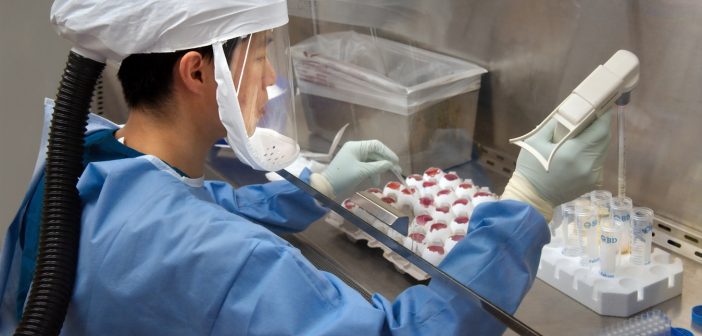Mahasweta Pal, freelance medical writer at Kolabtree, provides insights into the COVID-19 vaccine trial at the University of Oxford.
Update 22/05/2020: Oxford COVID-19 vaccine to begin phase II/III human trials
Update 30/12/2020: Oxford University/AstraZeneca COVID-19 approved
Update 04/08/2021: Barbie of Oxford Covid vaccine designer Dame Sarah Gilbert created
2020 ushered in an eerie global downturn with the COVID-19 pandemic, causing mass disruption among healthcare systems worldwide. Meanwhile, scientists in the United States and Europe jumped into the race to develop and launch vaccines against the pandemic SARS-CoV-2 infection with the shortest timelines. Stalwarts in immunology, virology, vaccinology, epidemiology, and public health have been contemplating the massive changes required in vaccine production and development strategies, owing to the current emergent need. One of the first to raise hopes while fighting this challenge was the University of Oxford, which has initiated phase I testing of its ChAdOx1 nCoV19 vaccine on April 21st, 2020.
The ChAdOx1 nCoV19 vaccine has been developed with the Spike glycoprotein (S) of SARS-CoV-2 added to the ChAdOx1 construct, which is a weakened version of a common cold-causing virus isolated from chimpanzees. There are quite many reasons why this trial holds promise, starting with its enrollment of healthy volunteers (who have not tested positive for the SARS-CoV-2 infection). Professor Sarah Gilbert and her team at the Jenner Institute have worked on previous viral diseases, including MERS-CoV and Ebola, and implemented their adenoviral vector delivery technology. In a statement to The Times, she said that she was 80% confident that the vaccine would work.
Professor Sarah Gilbert and her team at the University of Oxford’s Jenner Institute had started working on the anti-SARS-CoV-2 candidate vaccines in the early days of 2020 when just a few cases in Wuhan had been reported. This team has developed vaccines against MERS and Ebola virus in the past and has been readying itself up to respond to the crisis much before the global death toll crossed 200,000. With the announcement of this trial’s first patients receiving their vaccine doses, a silver lining seems visible. Therefore, here are a few clarifications regarding the design and other significant attributes of the trial.
What is the basic design of the ChAdOx1 nCoV-19 candidate vaccine trial?
The ChAdOx1 COVID-19 vaccine trial is a blinded, randomized, controlled trial with the MenACWY vaccine used as the control. The first two patients were each administered one of two vaccines. The study is currently recruiting participants only from four cities, namely Oxford, Southampton, London, and Bristol. The two randomized arms include 7 groups who will receive single or standard single doses of either 5×10^10vp ChAdOx1 nCoV-19 or the MenACWY vaccine on week 0, which would be followed with a 2.5×10^10vp ChAdOx1 nCoV-19 dose at week 4 (in one of the experimental groups).
Why is the MenACWY vaccine being used as a control?
This study is using the MenACWY vaccine as an ‘active control’ vaccine, to help investigators understand the participants’ response to the ChAdOx1 nCoV-19 vaccine. The MenACWY vaccine is a licensed vaccine against group A, C, W and Y meningococcal bacteria that is administered routinely to teenagers in the UK for protecting against the most common causes of meningitis and sepsis and is administered as a travel vaccine for high-risk countries. The reason for using this vaccine instead of a saline control is “because we expect to see some minor side effects from the ChAdOx1 nCOV-19 vaccine such as a sore arm, headache, and fever. Saline does not cause any of these side effects. If participants were to receive only this vaccine or the saline control and went on to develop side effects, they would be aware that they had received the new vaccine.” This is part of the blinding process to ensure that participants receiving any of the two vaccines would not show differences in their health behavior in the community following vaccination, which further helps to prevent any bias in the study results.
Professor Sarah Gilbert, the principal investigator for this registration trial also highlighted that the trial’s inclusion criteria will also enable understanding the number of carriers present in the trial since it is enrolling patients who have not been tested before, so it would provide a better understanding of the varying levels of the immunity after receiving the vaccine.
What are the primary and secondary outcome measures of the trial?
The main focus of the study is to investigate its action against COVID-19, and confirm that it won’t cause unacceptable side effects, and check if it induces reasonably remarkable immune responses. Essentially, the principal investigators will be checking the number of virologically confirmed (PCR positive) symptomatic cases in a period of 6 months and the occurrence of solicited local and systemic adverse symptoms following vaccination. The investigators will, on the basis of short term results achieved, conduct further outcomes analysis regarding the efficacy of the ChAdOx1 nCoV-19 vaccine candidate against severe and non-severe COVID-19 based on hospital admissions, ICU admissions, and disease exacerbation episodes.
In this trial, the seroconversion rates will also be monitored over 6 months to evaluate whether participants become seropositive for non-Spike SARS-CoV-2 antigens during the study period and quantify the antibody production rates in the participants. The trial design also includes testing of the cellular and humoral immunogenicity of ChAdOx1 nCoV-19 through the virus-neutralizing antibody assays against live and/or SARS-CoV-2 pseudotype.
What ChAdOx vaccines have been used in clinical trials? Where do they stand?
Adenoviruses, such as the ChAdOx1 construct, are attractive to be used vaccine carriers and delivery vehicles because they can initiate both innate and adaptive immune responses, and can be used with various antigens, including those of malaria, hepatitis B virus, hepatitis C virus, and HIV-1. The nCoV19 ChAdOx1 vaccine is the third ChAdOx-based vaccine and its dosages in the current trial have been decided based on the dosages of previous Influenza and MERS vaccine trials of 2002-2012. Prof. Gilbert’s work on Influenza has been revolutionary because the vaccine developed by her team is effective against all strains of flu, and induces powerful T-cell responses for long-term and universal protection. The viral vectored vaccine has been administered in combination with seasonal influenza vaccines to induce increased immunogenicity in older adults (aged between 50 and 85 years).
Prof. Sarah’s team at the Jenner Institute developed two new simian adenovirus-vectored vaccines (ChAdOx1 and ChAdOx2) and went on to develop viral vectored vaccines against Crimean Congo Hemorrhagic Fever (now in the GMP manufacturing stage), Nipah virus, and Lassa fever, both of which are in the preclinical stage; these vaccine development projects are being pursued in collaboration with Janssen Vaccines & Prevention B.V.& Prevention BV, the vaccine development, production, marketing, and distribution arm of Johnson & Johnson. The ChAdOx1 construct has been used even for vaccines even against Chikungunya and Zika viruses, which are under phase I testing currently. Professor Sarah has led all vaccine projects with respect to the in-house GMP manufacturing, production design, construction, quality control, pre-clinical testing, regulatory and ethical applications to Phase I and II clinical trials at the Jenner Institute.
Any other examples of adenoviral vector vaccines?
Apart from the ChAdOx1 vector vaccine constructs, the Modified Vaccinia Ankara (MVA) vector is another non-replicating adenoviral vector that enables increased widespread use among large populations with reasonable, longer-lasting safety profiles (6 months after the initial vaccination). For the MERS-CoV infection, the Jenner Institute tested candidate vaccines based on the ChAdOx1 and MVA vectors in humans and dromedary camels. In the phase I Ebola virus trial on 60 adult volunteers, a single dose of the chimpanzee adenovirus 3 (ChAd3) boosted with the MVA vector induced 8-fold superior immune responses. An anti-influenza vaccine based on the MNA vector, MVA-NP+M1 expresses a fusion protein of influenza A nucleoprotein (NP) and matrix protein 1 (M1) and exhibits T-cell and B-cell immune-boosting effects against conserved influenza antigens and induces augmented humoral immune responses.
How will the adverse events be clinically monitored?
Participants will be issued an electronic journal “E-diary” to record any symptoms experienced for 7 days after receiving the vaccine. They have also been instructed to record any instances of feeling unwell for the following three weeks. Following vaccination, participants will attend a series of follow-up visits, which will be dedicated to evaluating the participants’ clinical observations, blood sampling, and reviewing the competed E-diary. These blood samples would be used to assess the immune responses developed to the vaccine.
If participants develop COVID-19 symptoms during the study, they are requested to contact the clinical trial monitoring team, who will assess them to check for any infection with the virus. If a participant becomes very unwell, immediate attention from the hospital would be necessary to review the volunteer, if appropriate.
Funding received from for-profit or non-profit organizations
For its work on the anti-SARS-CoV-2 vaccine, the University of Oxford has entered an agreement with AstraZeneca AB, which will take over the large-scale manufacture and potential distribution of the vaccine. The University’s Oxford Vaccine Group has also received £20 million to enable taking up the production and distribution costs for the UK. The agreement also entails a not-for-profit basis for the duration of the coronavirus pandemic, which covers only the manufacturing and distribution costs. The University and the spin-out company Vaccitech will jointly have the rights to the technology platform used to develop the vaccine candidate and shall receive no royalties from the vaccine during the pandemic. Any royalties received eventually by the University will be reinvested directly into medical research, including a newly developed Pandemic Preparedness and Vaccine Research Centre in collaboration with AstraZeneca.
Possible timeline of the vaccine’s availability
- Sarah Gilbert: carving a path towards a COVID-19 vaccine. Perspectives, The Lancet. 395 (10232) P1247, APRIL 18, 2020.
- Lancet Infect Dis. 2020 Apr 20. pii: S1473-3099(20)30160-2. doi: 10.1016/S1473-3099(20)30160-2.
- Oxford COVID-19 vaccine begins human trial stage. Oxford University Press Release.
Need help with your coronavirus project? Consult virologists, epidemiologists and qualified scientific writers on Kolabtree. View our COVID-19 experts







